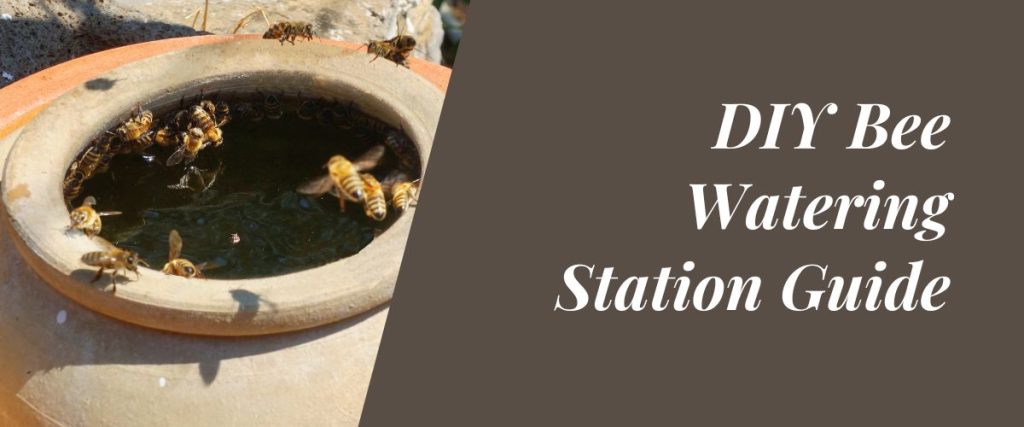Bees are remarkable creatures that play a crucial role in our ecosystem. They tirelessly work to pollinate flowers, ensuring the growth of fruits, vegetables, and flowers that sustain life on our planet.
However, during hot and dry weather, finding water can be challenging for bees. As responsible stewards of nature, we can help support these essential pollinators by creating bee watering stations.

In this guide, we’ll walk through the simple steps to make a bee watering station right in your own backyard.
Understanding Bee Watering Needs
Bees require water not just for drinking but also for regulating the temperature inside their hives. During hot weather, they use water to cool down the hive and keep the larvae at a suitable temperature. Providing a reliable water source can help bees thrive, especially during dry spells when natural water sources might be scarce.
Materials Needed
Gathering the materials for your bee watering station is a simple yet essential step in this endeavor. Here’s a more detailed look at what you’ll need:
- Shallow Container: This serves as the foundation of your bee watering station. Look for a shallow vessel such as a birdbath, shallow dish, or even a tray. The key is to ensure that the container is shallow enough to allow bees easy access to the water without the risk of drowning. You can repurpose items you already have or explore local stores for suitable options.
- Rocks or Marbles: Once you have your container, you’ll need rocks or marbles to fill it. These serve multiple purposes. Firstly, they provide a landing pad for bees, offering a stable surface for them to perch while drinking. Secondly, they prevent bees from accidentally falling into the water and drowning. When selecting rocks or marbles, opt for smooth, rounded ones to minimize any potential harm to the bees.
- Water: Of course, no watering station is complete without water. Choose clean, freshwater for your bee watering station. It’s essential to avoid using water that contains chemicals or pollutants, as bees are highly sensitive to contaminants. Regularly replenishing the water ensures that it remains clean and inviting for the bees. During hot weather, bees may consume more water, so keeping the station topped up is crucial for their hydration needs.
By gathering these simple materials, you’re laying the groundwork for a bee-friendly oasis in your backyard. Each component plays a vital role in creating a safe and accessible water source for our buzzing friends.
With the right materials in hand, you’re ready to embark on the journey of building your bee watering station and making a positive impact on local pollinator populations.
Building the Bee Watering Station
Now that you have all the necessary materials assembled, it’s time to roll up your sleeves and construct your bee watering station. Follow these detailed steps to create a welcoming oasis for our winged friends:
- Selecting the Perfect Spot: Take a stroll around your garden and scout for an ideal location for your bee watering station. Look for an area that receives partial sunlight throughout the day, as bees are more likely to visit a watering station that’s warm and inviting. Additionally, consider placing the station in a spot that is sheltered from strong winds. This helps prevent water from evaporating too quickly and provides a calm environment for bees to drink.
- Placement of the Container: Once you’ve chosen the perfect spot, place your shallow container in position. Ensure that it rests securely on a flat surface, such as the ground or a sturdy table. Stability is key to prevent the container from tipping over, especially when bees are landing and taking off.
- Adding Rocks or Marbles: With the container in place, it’s time to add the rocks or marbles. Carefully distribute them across the bottom of the container, creating a layer that covers the surface but leaves space for water to pool around them. The rocks or marbles not only provide a safe landing spot for bees but also add aesthetic appeal to your watering station.
- Filling with Water: Now comes the most critical step—filling the container with water. Slowly pour clean, freshwater into the container, ensuring that it covers the rocks or marbles but doesn’t submerge them completely. Aim to maintain a shallow depth of water, ideally no more than a few centimeters deep. This ensures that bees can access the water without risk of drowning while still having enough depth to drink comfortably.
- Monitoring and Maintenance: Your bee watering station is now complete, but the work doesn’t end there. Regular monitoring and maintenance are essential to keep the station in top condition. Check the water level regularly and replenish it as needed, especially during hot weather when evaporation rates are high. Additionally, inspect the station for any debris or algae buildup and clean it periodically to ensure a clean and inviting environment for the bees.
By following these detailed steps, you can create a bee watering station that not only meets the hydration needs of our pollinator friends but also adds beauty and functionality to your garden. Building a bee watering station is a rewarding endeavor that fosters a deeper connection with nature while making a meaningful contribution to bee conservation efforts.
So, grab your tools and get ready to create a buzzing oasis that will delight both bees and humans alike!

Tips for Success
Ensuring the success of your bee watering station goes beyond just setting it up. Here are some additional tips to enhance its effectiveness and support the well-being of our bee friends:
- Water Quality Matters: Bees are incredibly sensitive creatures, and the quality of the water you provide can significantly impact their health. Always use clean, chemical-free water in your watering station. Avoid using water that has been treated with pesticides or other harmful chemicals, as these can harm bees and deter them from visiting the station.
- Say No to Pesticides: Pesticides pose a significant threat to bee populations, so it’s essential to avoid using them near your bee watering station. Even small traces of pesticides can be harmful to bees, affecting their navigation abilities and overall health. Opt for natural pest control methods in your garden to protect both bees and other beneficial insects.
- Embrace Bee-Friendly Flora: Surrounding your bee watering station with bee-friendly flowers is a surefire way to attract more visitors. Choose a variety of flowering plants that bloom at different times of the year to provide bees with a continuous source of food. Native plants are especially beneficial, as they have evolved alongside local bee populations and provide the nectar and pollen they need to thrive.
- Create a Bee-Friendly Habitat: In addition to providing water, creating a bee-friendly habitat in your garden can further support bee populations. Incorporate features such as flowering plants, nesting sites, and undisturbed areas where bees can forage and rest. Avoid using mulches or weed barriers that can block access to the soil, as many bee species nest underground.
- Educate Others: Spread the word about the importance of bee conservation and the role of bee watering stations in supporting bee populations. Encourage your friends, family, and neighbors to create their own bee-friendly habitats and watering stations. By working together, we can make a significant impact on bee conservation efforts and ensure a thriving future for these essential pollinators.
By implementing these tips, you can maximize the effectiveness of your bee watering station and create a welcoming environment for bees in your garden.
Remember, every small action counts when it comes to supporting bee populations, so don’t underestimate the positive impact you can make by providing a safe and reliable water source for our buzzing friends. Together, we can protect and preserve these vital pollinators for generations to come.
Conclusion
Crafting a bee watering haven isn’t just a hobby; it’s a profound gesture of gratitude to these vital pollinators. By offering them a reliable water source, we empower them to continue their essential work, even in the face of adversity.
So, roll up your sleeves, gather your materials, and embark on this noble endeavor to make a tangible difference for the bees in your backyard. After all, in the delicate dance of nature, every small act of kindness resonates magnificently.





